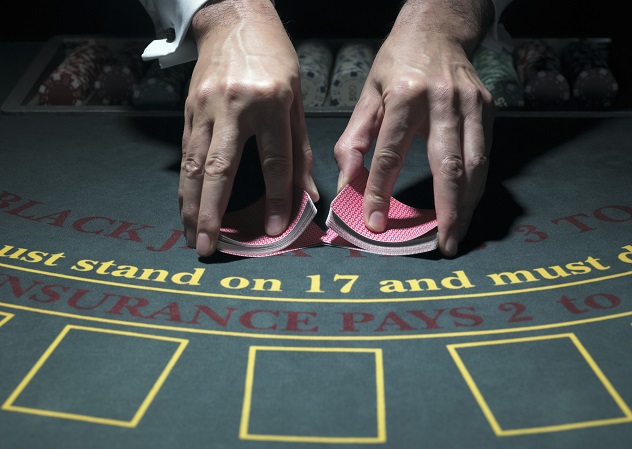 Humans
Humans  Humans
Humans  Animals
Animals 10 Species That Refused to Go Extinct
 Weird Stuff
Weird Stuff 10 Weird Things People Used to Do at New Year’s
 Our World
Our World 10 Archaeological Discoveries of 2025 That Refined History
 Weird Stuff
Weird Stuff 10 Fascinating Facts You Might Not Know About Snow
 Miscellaneous
Miscellaneous Top 10 Things Crypto Was Supposed to Change & What Actually Did
 History
History 10 Huge Historical Events That Happened on Christmas Eve
 Music
Music 10 Surprising Origin Stories of Your Favorite Holiday Songs
 History
History 10 Less Than Jolly Events That Occurred on December 25
 Weird Stuff
Weird Stuff 10 Funny Ways That Researchers Overthink Christmas
 Humans
Humans 10 Unsung Figures Behind Some of History’s Most Famous Journeys
 Animals
Animals 10 Species That Refused to Go Extinct
 Weird Stuff
Weird Stuff 10 Weird Things People Used to Do at New Year’s
Who's Behind Listverse?

Jamie Frater
Head Editor
Jamie founded Listverse due to an insatiable desire to share fascinating, obscure, and bizarre facts. He has been a guest speaker on numerous national radio and television stations and is a five time published author.
More About Us Our World
Our World 10 Archaeological Discoveries of 2025 That Refined History
 Weird Stuff
Weird Stuff 10 Fascinating Facts You Might Not Know About Snow
 Miscellaneous
Miscellaneous Top 10 Things Crypto Was Supposed to Change & What Actually Did
 History
History 10 Huge Historical Events That Happened on Christmas Eve
 Music
Music 10 Surprising Origin Stories of Your Favorite Holiday Songs
 History
History 10 Less Than Jolly Events That Occurred on December 25
 Weird Stuff
Weird Stuff 10 Funny Ways That Researchers Overthink Christmas
10 Clever Casino Scams In Recent History
As long as casino games have existed, there have always been those who want to find a way to beat them. Some have sought out guaranteed ways to win without actually breaking the rules, but most approaches are simply one big scam. Some of these fraudsters have gone to great lengths to devise complicated cheats.
10New York Roulette Ring

In 2012, casinos in Ohio were invaded by a New York crime ring involved in a roulette scam. According to the Ohio Casino Control Commission, the group consisted of roughly 50-70 people who scoured the country ripping off United States casinos.
In this scam, the players entered the game with low bets (sometimes as low as $1 per chip). They secretly pocketed certain colored chips while another player distracted the dealer. The first player then excused himself from the table and secretly passed the chips to another member of the gang. That second member then hit another table, assigned a higher value to that chip’s color, and cashed out at the new rate.
They were discovered after pulling the scheme in four different Ohio cities. Four men were arrested and pled guilty, but it is speculated that more were involved and had fled before officials arrived. The commissioner on the case estimated that the group was able to pick up $1,000-$2,000 per scam during their Ohio rounds, but it’s impossible to tell how much they racked up as a group over the years. In addition, nobody knows for sure how many scammers are still at large or if they’re still actively hustling.
9The Roselli Brothers

From 1995 to 2000, a couple of scam artists who called themselves “the Roselli Brothers” were able to obtain over $37 million from casinos in New Jersey, Nevada, and Puerto Rico without spending a single penny. How did they do it? With identity theft and unbelievable persistence.
To pull off the grand scheme, the brothers hired a computer hacker to pull data from credit systems and find people with excellent credit. Accounts were opened in those names, the Roselli brothers put $50,000 of their own money into them, and they received credit lines with all the major casinos within six months.
They continued this scam for five years thanks to offset betting procedures and perfectly timed gambling schedules. That way, they could make the gaming officials believe they were losing money while their associates won big on the other side. They then paid all outstanding markers, and their casino credit lines increased to upward of a million dollars.
Over New Year’s weekend in 2000, they exited the casino scamming game permanently with a huge blowout in Las Vegas. They ran their scheme through many casinos in one night—with bets as high as $100,000 per hand—before collecting their ample winnings and disappearing forever. It took six additional months for the FBI to figure out that the scam had even taken place. By then it was too late, as they discovered the real Roselli brothers had actually died many years previously. The true identity of the scammers is still unknown.
860-Second ATM Scam

Not all casino scams take place at the betting tables. Sometimes, all you need is a debit card to steal thousands of dollars from the biggest casinos in the world.
In 2012, 14 conspirators were charged with the theft of over $1 million from Citibank using casino kiosks in California and Nevada. The scam involved exploiting a gap in the kiosk security that allowed multiple unrecorded withdrawals within a 60-second opportunity window.
The ringleader, Ara Keshishyan, recruited a team to open multiple checking accounts from Citibank. The group would then go to casinos all over Southern California and Las Vegas and use their Citibank cash advance kiosks to withdraw up to ten times the amount of money deposited into the accounts using the one-minute security gap. They were careful to keep their deposits and withdrawals under $10,000 so federal agents remained at bay.
Once the money was collected at the cages, Ara would take a considerable cut from his co-conspirators, and the rest would be split to gamble among the team. They were comped for rooms, food, drink, and entertainment during their scheming and never had to pay for a single thing.
Ultimately though, all this scheming did not pay off. Ara was arrested and charged with 14 cases of bank fraud. If convicted, he could receive 30 years in prison and a $1 million fine per count. His conspirators each face up to five years in prison and $250,000 in fines.
7French Cigarette Pack Scam

In the summer of 1973, one of the greatest roulette scams took place at the Casino Deauville in France. It involved a radio amateur (who was also a casino roulette dealer), his brother-in-law, and his beautiful sister.
The dealer created a radio transmitter which fit perfectly into a pack of cigarettes. He also turned a weightless receiver into a roulette ball which he used at his table. His brother-in-law posed as the unknowing player placing bets while the sister served as the “button pusher” holding the cigarette pack. Once she pressed the transmitter’s button, the ball would descend from its spin and land in groups of six possible numbers with an impressive 90% accuracy. She always stood one table over to remain inconspicuous to officials on the floor.
In just one week, the trio managed to score 5 million franks, which at the time was roughly $1 million USD. Casino officials caught wind of what was happening and became suspicious. They investigated every possibility from a defective wheel to the (accurate) assumption that the dealer was corrupt. They spent weeks with experts but could find nothing out of the ordinary.
The scammers’ downfall came after the casino owner took a romantic interest in the sister. He made a move on her and was quickly turned down. Shortly thereafter, he began to notice her presence in a different light. He made the connection that she was always in the casino whenever the same person at the same roulette table consistently won large amounts of cash. He put these clues together, suspected radio interference was to blame, and had a debugging team sweep the floor.
Eventually, the team was caught and arrested. If only the sister hadn’t been so alluring and beautiful, they might have gotten away with their brilliant plan.
6The Cutter Gang

The “Cutter Gang” cheated their way to millions at the baccarat table in 2011. They were able to beat the system by accepting the standard offer to cut the deck after the dealer shuffled the cards. A member would then drag one particular card (the “cutting card”) along the deck while separating the cards before placing it back in the deck.
What made the scheme foolproof was that the same player had a tiny camera hidden in his cufflink to see the card values. That player would then excuse himself to give the camera and information to another member of the gang. They would return with winning hands every single time.
The gang was detained in Las Vegas at the Cosmopolitan casino in January of 2011 after suspiciously raking in over $1 million, but they were released after authorities found no evidence of wrongdoing. They were later arrested for cheating in the Philippines, but they escaped shortly after and have been missing ever since.
5Cannes Contact Lens Scam

In 2011, three Italians and a Frenchman managed to swindle nearly 64,000 Euros (roughly $84,000 USD) from the Princes Casino in Cannes using an ingenious method. While playing stud poker, the Frenchman would mark symbols on card decks with invisible ink, while the Italian players wore special contact lenses to see the markings.
Suspicion was raised after the group returned with a second substantial winning streak in the same casino. Police were called to investigate, and they were able to find the symbols marked on the cards which included a short line to represent an ace and a cross to represent a king.
It took a while longer to figure out how the players were able to see the ink. After ruling out the possibility of camera usage, they finally noticed each player sported contact lenses nobody had ever seen before. The players were caught and, despite the cool and sneaky nature of their scheme, faced a long jail sentence.
4Ritz Roulette Scam

In 2004, a trio of gamblers from Hungary and Siberia managed to take £1.3 million (or roughly $2.1 million USD) from the Ritz Casino in London by allegedly utilizing laser technology. Incredibly, they got to keep the money.
It is thought that the trio used a technique based on a theory called “sector targeting,” which uses figures to determine the “decaying orbit” and devises a likely set of outcomes regarding where the ball will rest.
The group supposedly used laser scanners in their phones that were connected to a computer that predicted the numbers likely to win big in roulette. The scanner could judge the roulette ball’s speed and suggest which numbers it might land on. Thus, the group was able to make calculations fast enough to place their bets before the ball made its final rotation.
The gang was arrested but, since “sector targeting” isn’t technically considered cheating, they were let go with no charges.
3Phil Ivey Jr. Edge Sorting Scam

Allegedly, championship poker player Phil Ivey Jr. schemed his way to $9.6 million at a baccarat table in 2014. He did it at the Borgata Hotel Casino and Spa in Atlantic City using a technique called “edge sorting.” A player sorting edges does so by observing any defects or abnormalities in certain cards. They then memorize these imperfections and use them to identify the cards correctly in the future.
Although it sounds like a fair tactic, edge sorting is frowned upon by most casino officials, especially the way Ivey did it. He and his partner noticed that some of the table’s cards had diamond shapes and patterns with defects on the back. Some had full diamonds while others were cut in half. Ivey and his partner would then instruct the dealer to flip the “good” and “bad” cards over in certain, prearranged directions. This allowed Ivey to more easily identify the cards and make all the right bets.
The Borgata has filed a lawsuit against Ivey over the scheme. He has denied any and all misconduct, but this is the second edge-sorting lawsuit he has been dealt over his career. If Ivey gets away with this, he’ll officially be one of the most successful scammers in the game.
2Phuong Quoc Truong Gang

A man named Phuong Quoc Truong (also known as Pai Gow John) assembled a team of illegal card counters by traveling the US and convincing dealers to cheat for him. By the time he entered the grand scheme, he had 30 accomplices.
To carry out the scam, the corrupt dealer would give the illusion of shuffling cards. In actuality, he would just put the corners together so the deck would make a shuffling noise while the cards remained in the same order. Meanwhile, the main player would pretend to smoke a cigarette while whispering information about the dealt cards to an outside player via a microphone hidden in his sleeve. Once given his instructions, the smoker would then place his fingers on his cigarette in a certain way. This was a code to the other players that directed them to make their bets.
The group managed to make over $7 million from 25 different casinos before they were caught. The Sickwan Gaming Commission discovered Phuong and his accomplices though the security surveillance footage, and they were promptly arrested. Many pled guilty and are currently serving time in prison. Poor Phuong actually had to give up two of his homes and a Porsche in addition to other luxuries.
1Australian Danny Ocean

In 2013, an unknown man was able to steal $33 million AUD ($30 million USD) from the Crown Casino in Melbourne, Australia after hacking into the surveillance system. It was a heist straight out of Ocean’s Eleven, and the hunt still continues for the man’s identity.
Although the casino has not officially revealed details about how the scheme was carried out, a Las Vegas casino consultant named Barron Stringfellow has deduced how it was accomplished. He suspects that the player was wearing an earpiece and playing at the VIP tables, while an accomplice surveyed the surveillance footage from a safe location inside or around the casino. The accomplice then relayed what bets and plays to throw down for maximum profit.
The only extra detail released about the case states that the VIP staff member responsible for looking after the gambler on the night of the heist has been dismissed. It is unknown, however, whether he was involved in the scam or not. The Crown Casino is optimistic about recovering the money, but officials counter that the chances are nigh impossible.
Morgan Swank is a professional joke writer, social media guru, and all-around list maker. She tried counting cards once. Follow her on Twitter @MorganSwank.








